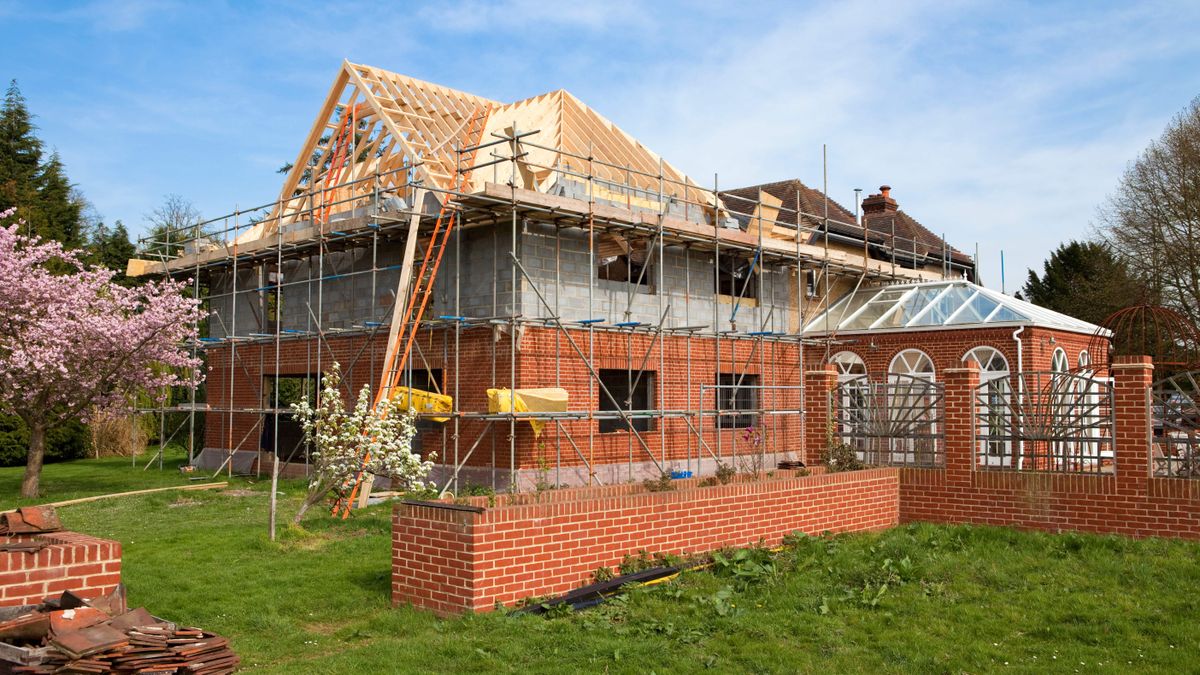Infill plots can provide budding self builders with the perfect opportunity to build their own home, but what exactly is an infill plot?
Imagine strolling through a bustling village, with streets lined with houses and generous gardens. At first glance, it appears that every inch of space is occupied. However, a closer look reveals a different story.
Nestled between these buildings lie small parcels of unused land – perhaps a disused garage between two gardens or an overgrown, forgotten garden adjacent to a house. These spaces, often overlooked, are ripe with potential as self build plots.
Here, I delve into the detail of what constitutes an infill plot, how to find an opportunity in your chosen area, as well as both the benefits and potential challenges you might face when developing this type of land.
What are infill plots?
In planning terms, turning unused or vacant pieces of land in developed areas into something useful is called infill development. Rural councils often define infill plots as ‘the infilling of a small gap within an otherwise built-up area’.
Infill plots come in all sorts of forms, from garden plots to large driveways and vacant parcels of land to the side of existing homes. Typical prospects may also be the site of redundant garages or outbuildings that can be replaced with a house.
These plots can be a bit awkward – they might be an odd shape or unusually small. However, with clever design input, self builders can turn them into great places to live.
What are the benefits of infill plots for self builders?
Infill developments are usually thought of as sites in established settlements, such as villages and towns. From a planning perspective they present less risk than, say, a greenfield plot. As such, whilst there will be site constraints to deal with, provided your proposal does cause harm or a loss of amenity to its neighbours, the chances of securing planning consent is usually high, even in locations such as conservation areas, provided your plans are deemed to improve and enhance the area.
In general terms, the planners consider infill plots as less disruptive and preferable to less sustainable sites. This is why some local councils approve infill projects even in small hamlets within open countryside, since the development does not lead to urban sprawl.
What’s more, unlike undeveloped greenfield sites, or brownfield sites that might need a lot of work to make them developable, infill plots are usually already set up with essentials services such as water, electricity, internet as well as access to the main highway. This means they’re not as costly for self builders to develop.
Are there any potential challenges?
Infill development isn’t without its challenges, though. Here are some of the main hurdles you may face:
- Getting neighbours on side with your plans to build an extra home next to their property can be tough, especially if they’re worried about the impact on their home and its value. Plus, they’ll have to deal with the noise and disruption from construction, which can be a real headache.
- And then there’s planning permission. Often, it’s all about the design and self builders need to consider how their project will impact the neighbours, and will need to address issues such as blocking light to their property or overshadowing their gardens.
- Infill plots are often odd shapes and sizes and any proposals will not only have to fit the land concerned but will also have to deal with the constraints such as how it fits in the street scene from a scale and massing point of view.
- There’s access to consider too, as these plots can often be tucked away in tight spots or hard to reach by road, so getting building materials to the site needs some clever planning.
- On a related note, there is the issue of having a safe and legal access, which might be challenging with corner plots.
- You’ll also want to establish early on whether there are any restrictive covenants on the land that may make your plans unviable. Some covenants restrict or prevent development while others may require an overage payment to be made when the land is developed.
Finally, with all of the above considered, as with any type of plot, you’ll need to consider how much the building plot is worth and whether your plans are financially viable.

How do you find infill plots?
Find your perfect plot

Find your perfect building plot with Plotfinder.net – the UK’s largest plot and renovation-finding platform, with over 15,000 opportunities available.
When it comes to finding an infill plot, or any other plot type for that matter, having a clear strategy is crucial. Randomly searching for land is mostly pointless and usually leads to disappointment.
An effective strategy should identify what you’re looking for, where you’re likely to find it, and how much you’re willing to spend. A well-thought-out plan will also help to avoid common pitfalls.
The first step in your strategy is to clearly define what you’re looking for. Think about how big the plot needs to be, what type of house you want to build and any specific features that are non-negotiable when it comes to building a house on the site.
Once you have a clear vision, the next step is to concentrate your search on specific areas. Instead of looking everywhere, focus on towns or villages where you’re more likely to find what you need, and then look out for houses with larger gardens or with outbuildings that could be replaced.
There isn’t just one way to find the perfect infill building plot and by using a mix of different tactics you can significantly increase your chances of success. Here are the main tactics to consider:
- Target off-market opportunities: One of the best ways to secure a plot is to avoid competition by looking for land that isn’t yet on the market. Off-market land includes forgotten pieces of land or properties with potential for redevelopment that haven’t been advertised for sale. These opportunities are often found by networking and referral or by directly approaching landowners who may not have considered selling.
- Use specialist plot-finding websites: Websites like Plotfinder.net are tailored specifically for self builders, making them a great place to browse qualified self build opportunities. They’re the best place to see what’s out there and get a feel for market prices. But remember, competition can be fierce, so if you see something, be ready to act fast.
- Get out and explore: Nothing beats exploring an area in person. Walking around can give you a better sense of opportunities. If you find something interesting, don’t be shy — ask locals about available land or drop letters through doors to express your interest.
- Spread the word: You never know who might have a lead on the perfect plot, so let everyone know you’re looking. Talk to friends, family, and even casual acquaintances. Consider putting up ads in local shops, notice boards or on social media to cast a wider net.
- Consider land you already own: Sometimes the perfect plot is right under your nose. If your house is in desperate need of renovation or if you own a large garden, it might be more suitable as a building plot. Provided the planning department will support your proposals it might be far quicker and easier to build on something you already own.
- Network with builders and professionals: Building relationships with those in the self build industry can lead to insider information on plot opportunities. Architects, planners, project managers and self build companies often know of opportunities before they’re publicly listed.
- Attend property auctions: Property auctions aren’t just for buying old, dilapidated houses — they can also be a great source for building plots. Just be sure to do your due diligence by studying the auction pack and working out what your maximum bid should be. Remember, the fall of the hammer represents exchange of contracts so be doubly certain about what you’re doing before making any bids.
- Look for properties for sale with large gardens: Properties that are poorly placed on the plot might offer the perfect chance to buy a house and carve off the side garden to create a plot. Look for opportunities for sale with estate agents but consider alternative development options which might not have been considered by the vender or the agent.
- Study maps: Maps are invaluable tools for spotting potential plots. Google Maps, Ordnance Survey and professional tools like Promap or Searchland provide an enhanced level of information and can identify areas with development potential. If you spot a promising infill plot, look at the plans attached to the Local Plan or on the planning portal of your local authority. The maps show lines drawn around built-up areas. These lines are known variously as development boundaries, settlement boundaries, built up-area boundaries and so on. The lines are usually drawn fairly tightly around the main built-up areas of towns and villages and often exclude peripheral areas of low-density housing.
- Use the council’s planning portal: Every council must advertise and consult on planning applications. The planning portal is typically found via the main council website, under the planning tab. It’s a treasure trove of information where you’ll find digital maps as well as recently approved projects or applications that were denied but could be approved with some changes.
If you find an infill plot it’s critical that you not only assess it against your land buying checklist but you’re prepared to compromise. The perfect plot is rare, so if you’re not willing to compromise, you may be looking for a very long time.
Focus on what’s most important to you, whether it’s location, plot size, or specific features. For example, while a large plot might sound appealing, most infill plots won’t have much land so a smaller plot is more likely. Securing planning consent will also be affected by the neighbouring houses, so take the question from these and work up a design that’s coherent with the street scene and existing architectural style.
How do you assess the potential of an infill plot?
Whether you can build on an infill plot depends very much on its location and the policies that apply there. So, you’ve found a plot with infill potential, but how do you know what you can build on it?
Most councils allow for infilling and small-scale developments within towns and villages. Some define categories of settlements, from larger towns down to small hamlets, with differing rules for each.
Contrary to the political and media hype, councils are still encouraging property development. Government planning policy still allows for building in a home on a garden in built-up areas, and most councils still allow infill developments, including within gardens.
There are, however, areas in towns and villages where infill is restricted. These might be conservation areas or areas with some special character. This doesn’t necessarily mean you can’t build, but permission is going to be harder to come by. There are likely to be design constraints as well.
The things to look at are the types of houses on either side of the site and in the area generally. You should also consider the pattern of development (more on which later), plot privacy and whether the new house will be excessively overbearing.
You should also review access (a residential plot without vehicular access can make the project unviable), and any particular features of the site such as a slope, trees, existing buildings and so on.
You can get a good idea of what can be built on an infill plot by looking at its neighbouring properties. If they’re bungalows, the likelihood is you’ll have to build a bungalow. If the neighbours are two-storey houses, then another house would probably fit in best. There are no hard and fast rules, but an infill house must fit in with its neighbours to a reasonable degree.
How do you maximise your chances of obtaining planning permission on an infill plot?
As with all plots there will be a range of planning considerations which must be dealt with before planning permission can be granted.
It’s important to consider the pattern of development. This refers to the sizes of plots and the position of houses within those plots. If the pattern is close-knit, you might be able to squeeze an infill plot in a gap of little more than 10 metres between houses. If the pattern is more spacious, a house that was too crammed in might look out of character and is likely to be resisted by the local planning authority.
The same goes for the house positions on the plot. If all the houses in the road are set well back, then your infill house should be too.
Privacy is also an important consideration. The key questions here are: would the plot have adequate privacy, and most importantly, would a new house on the plot affect the privacy of neighbours? Hedges and fences usually protect privacy at ground floor level, so the issues tend to arise from first and second floor windows either looking into neighbours’ windows or down into their private garden space.
Privacy issues rarely affect whether a plot can be built on, but they do affect how windows must be carefully positioned to avoid overlooking. Often this means putting obscured glazing in landing or bathroom windows on the sides of the house, with the main bedroom windows facing to the front and rear.
An infill house is bound to have some effect on its neighbours in reducing the light to their windows and perhaps to their gardens. There’s a fine line between what’s a reasonable level of overshadowing and what’s not.
Look at the neighbouring houses carefully to see where the windows of the main rooms are positioned. If the main living room or kitchen windows are on the side of the house, you might have to site the new house a little farther from the boundary to ensure it won’t restrict light too much.
In the same way, a new house could be regarded as overbearing if it’s too close to another. Although no one has a right to a view, planners do get concerned about the more nebulous concept of outlook. Where a house enjoys an open outlook, hemming it in with a new house might be seen as being harmful to the amenities of the occupants.
Access is a key consideration, too. Infill sites are often narrow, making it difficult to provide adequate access, on-site turning (where necessary) and parking. An integral garage can save space, and sometimes it’s possible to share a drive with a neighbour.
Parking planning conditions and requirements are less onerous these days and in central areas of towns, where there’s good public transport available, on a really small plot it might be possible to build without any on-site parking at all.
When it comes to the value of an infill plot, its value will reflect what the finished house is worth, less the cost of development. (Find out more on the latter with our guide to how much does it cost to build a house.) To a degree, the valuation process is mechanical and an infill site won’t necessarily be cheaper than any other plot.
There are a few wider considerations, such as the impact on the value of adjacent properties, particularly if you own the house where the infill plot is being carved off. A close eye must be kept on whether the value of the existing house is impaired such that development is not viable.

Plotfinder.net is Homebuilding & Renovating’s sister site that has thousands of self build and renovation opportunities from estate agents, auction sites and private owners across the UK. Subscribe today and get email alerts for potential plots straight to your inbox.

